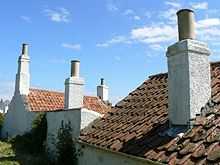Pantile
A pantile is a type of fired roof tile, normally made from clay. It is S-shaped in appearance and is single lap, meaning that the end of the tile laps only the course immediately below. Flat tiles normally lap two courses.[1]
A pantile-covered roof is considerably lighter than a flat-tiled equivalent and can be laid to a lower pitch.[2]
Pantiles are used in eastern coastal parts of England and Scotland including Norfolk, east central Scotland, the Lothians and Fife, where they were first imported from Holland in the early 17th century.[1] They are rarely used in western England, except in the Somerset town of Bridgwater.[2]
Roofing pantiles are not to be confused with a type used for paving, after which the Georgian colonnade in Tunbridge Wells is named. Whilst called pantiles, the paving tiles which were installed there in 1699 were one-inch-thick square tiles made from heavy wealden clay, so named because they were shaped in a wooden pan before firing.[3] The pantile paving in Tunbridge Wells was replaced with stone flag tiles in 1792.
References
External links
![]() Media related to Pantile roofs at Wikimedia Commons
Media related to Pantile roofs at Wikimedia Commons
